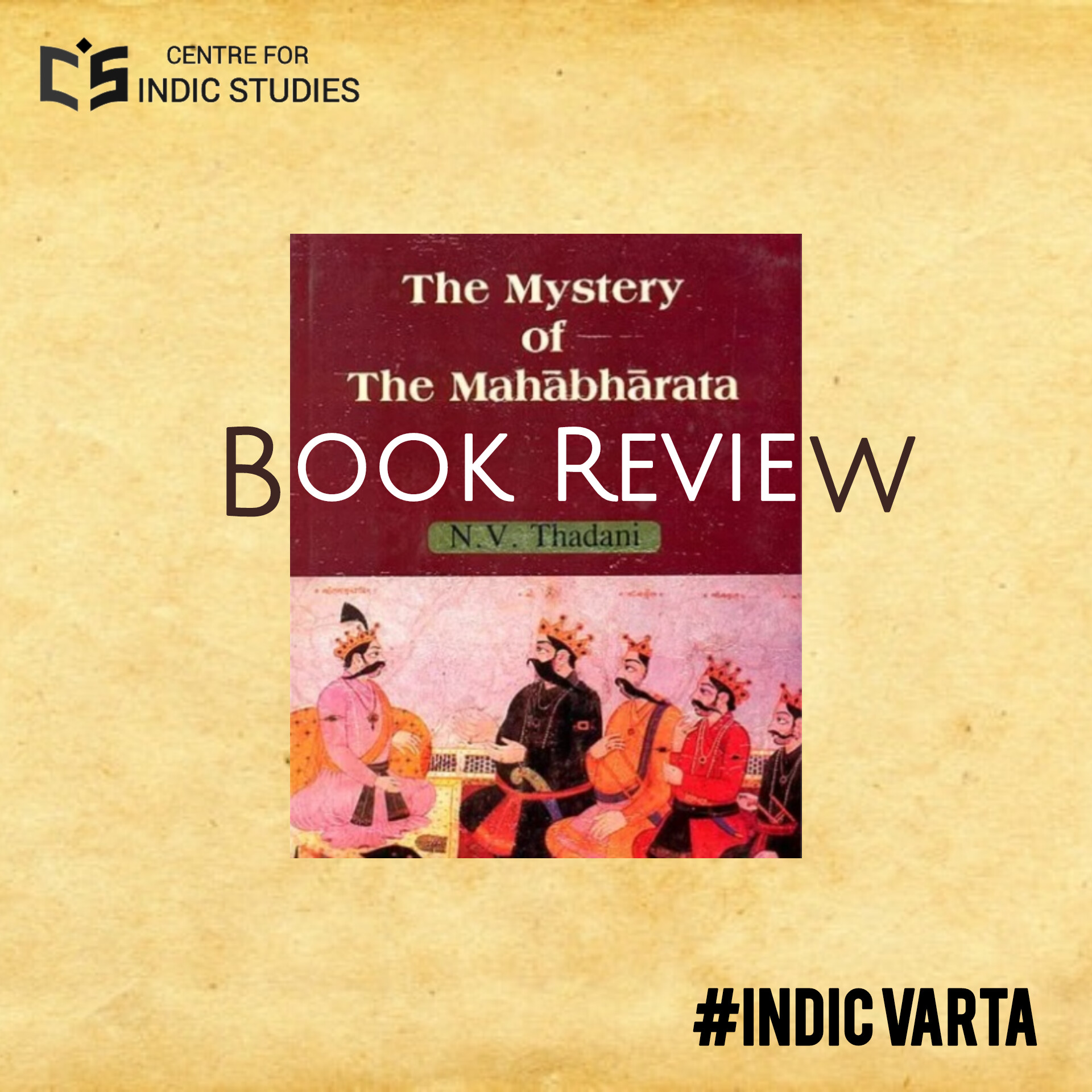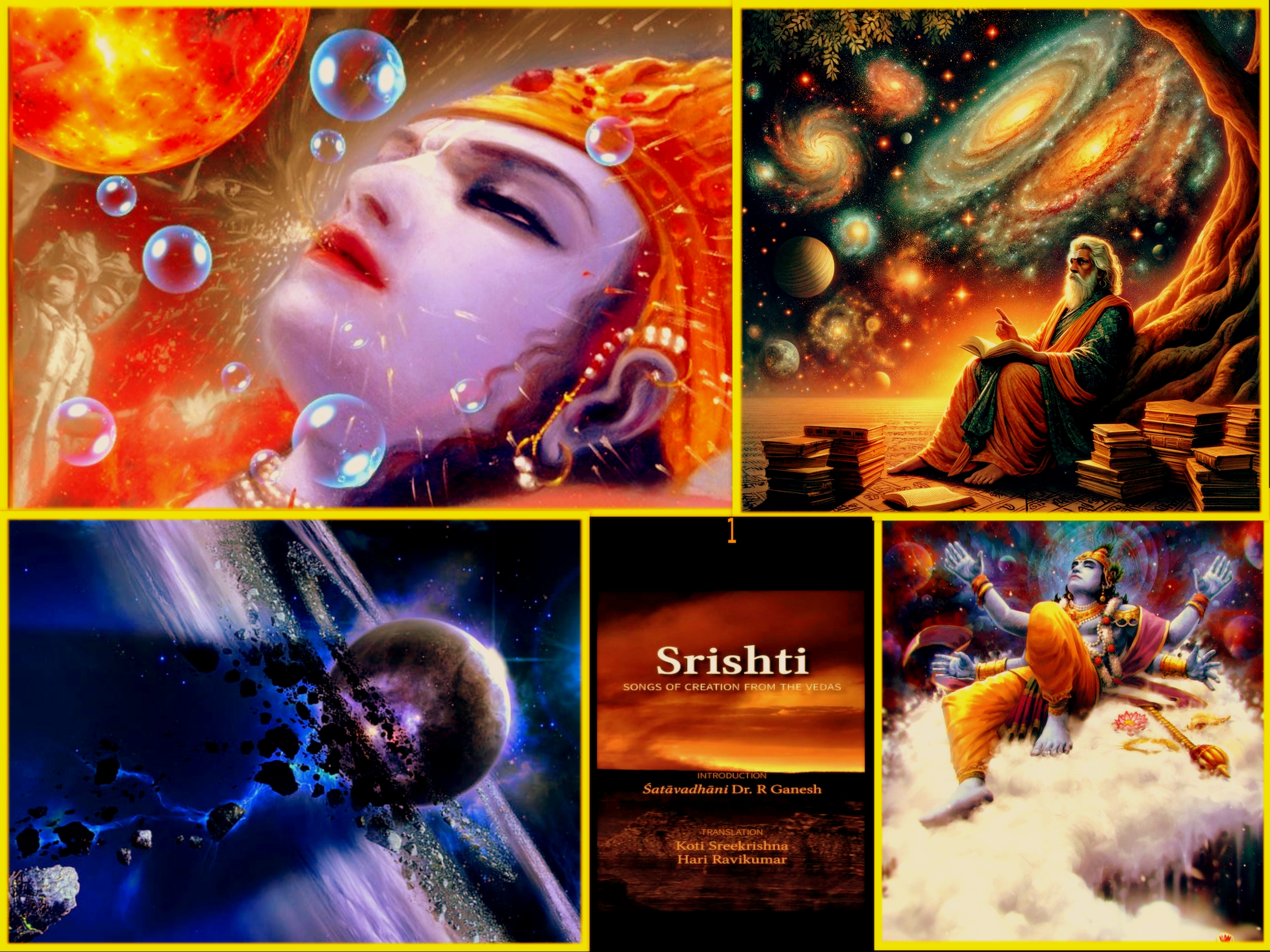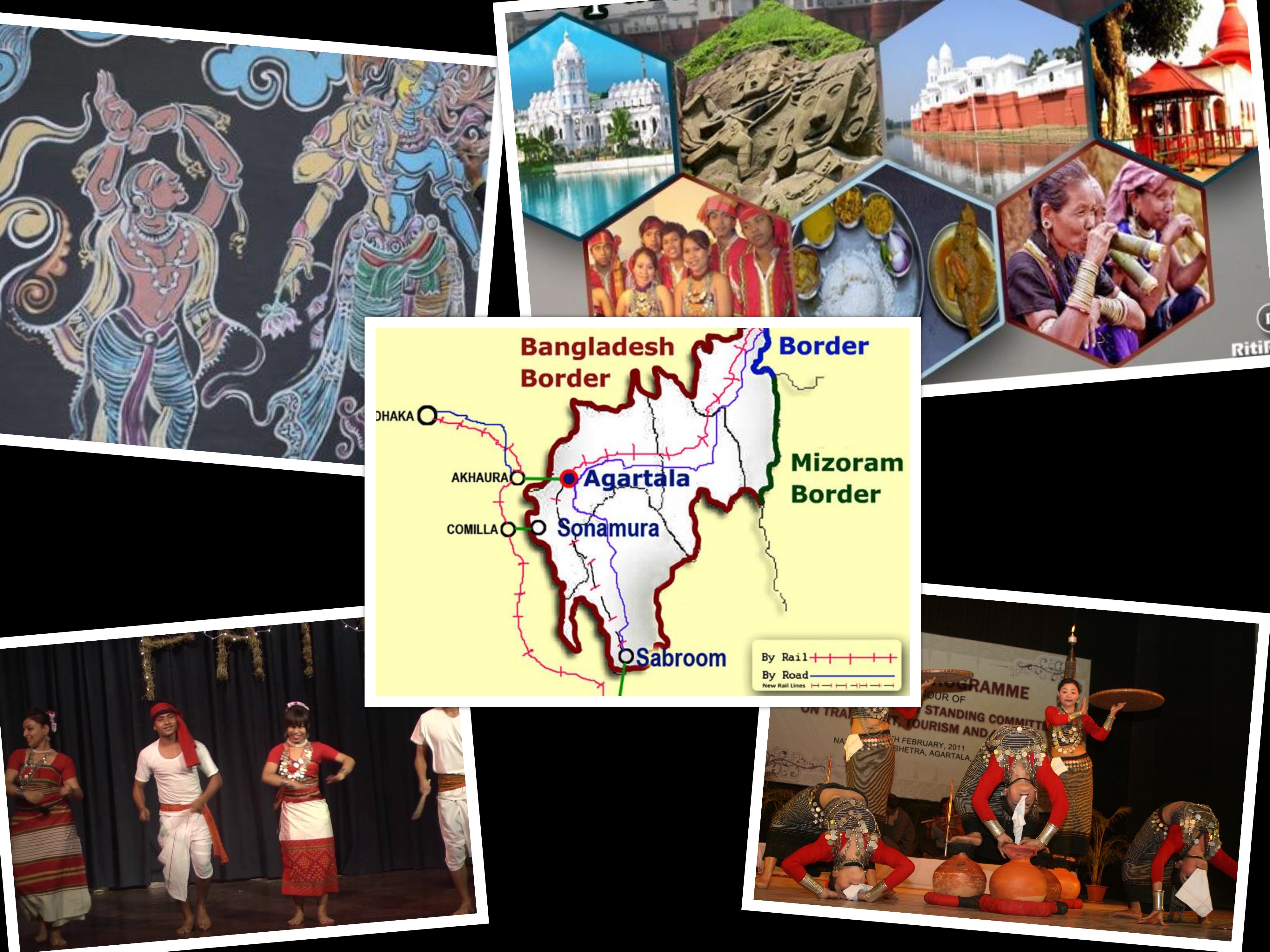- Visitor:56
- Published on: 2024-09-27 02:26 pm
A Book Review of the Mystery of Mahabharata by N. V. Thadani (Part 1)
Similar to how the star cells are also born, then live, and ultimately die, the author connects the idea of the hiranyagarbha or the brahmanda with the modern scientific idea of cells. And, this is the great ovum of the cosmos that is composed of the purusha and prakriti from where the grand creation surges up.

The claim that ancient India lacked scientific inquiry is a huge misunderstanding. The early sages of Bharat were the architects of an insightful and innovative approach to comprehend the natural world— a truth elegantly woven into the fabric of the Vedas, Upanishads, and the six systems of Hindu philosophy. These ancient texts throbbed with an insatiable curiosity about the cosmos and the intricacies of life showcase a ferocious determination to unveil the laws and theories lying within.
At first glance, the Vedic hymns may seem to be mainly paying attention towards reverence for the creator, rituals and deep philosophical musings. Yet, beneath this surface, a scientific spirit thrums with vigour. It is here that the first seed of Indian scientific inquiry took root, nurturing the growth of disciplines like life sciences, cosmology, physics, medicine, and linguistics. The wisdom of the ancient Hindus to explore the realms of knowledge may rival any of the contemporary civilizations, and may often surpass them in fervour and depth.
The intellectual pursuits of these sages transcended mere speculation. They were marked by a disciplined and methodical exploration of the universe, peering into the unseen. This unyielding quest for understanding, fueled by both spiritual and pragmatic motivations, laid the foundation for a sophisticated comprehension of existence that is still unparalleled in its era. The legacy of this scientific endeavour not only highlights the remarkable intellect of ancient India but also whispers secrets through the ages— beckoning contemporary research into the vast unknown.
Now let’s get back to the main topic. It is about exploring NV Thadani's book The Mystery of the Mahabharata (Vol. I). The author is the former Principal of the Hindu College and the former Rector of the University of Delhi; He has also written books titled Author of Krishna's Flute and Other Poems, The Bhagavadgita: Centenary Edition and Hindu Philosophy of Religion: Mīmaṁsa Sūtra of Jaimini. In this book the author has made an attempt to provide us with a thought-provoking reimagining of the Mahabharata with a rich and intellectual framework to appreciate the epic at a deeper-level. A significant portion of this work is devoted to discuss the idea of organic cells that the author himself claims to be the foundation to Indian thought. This fact suggests that, in the case of Hindus, the most complex philosophical and religious ideas can be traced to the concept of fundamental life force. Moreover, the way this book is divided into several chapters on totally different themes reflects the meticulous and scholarly approach, although it may demand a patient and attentive reading throughout.
The Meaning of the Mahabharata
In the first chapter titled “The meaning of the Mahabharata”, the writer highlights how the epic is a profound philosophical treatise rooted in ancient Indian thought, rather than merely a collection of stories. It uses a unique form of Sanskrit that, while appearing narrative, carries deeper meanings and which is further analysed in the subsequent chapters. In the chapter titled “A New language”, NV Thadani explains how the Mahabharata is crafted in a unique lingo of Sanskrit, encapsulating complicated philosophical thoughts. No doubt, apart from the two epics i.e. the Ramayana and the Mahabharata, no other Sanskrit text has been so immensely popular among the masses. Here, the contribution of Mahabharata to Sanskrit literature is also undeniable. The language, considered divine and intricate, needs deeper understanding for appreciating its meanings. And, to comprehend its deep insights, origin and grammatical intricacies of Sanskrit are needed to understand.
The Systems of Hindu Thought
Now, let us come to the next chapter, “The Systems of Hindu Thought”. First, the reader has to understand that we are to explore the infinity and beyond. Here, we have to face every kind of cell as a form of new world to discover. Further, we know there are almost two hundred types of cells and all of them are divided into multiple subtypes. This can be compared with the galaxies and its corresponding system of stars, stellar remnants, interstellar gas, dust and dark matter or the globe with different nations having their own languages and cultures. This is an astounding diversity to map. Similar to how the star cells are also born, then live, and ultimately die, the author connects the idea of the hiranyagarbha or the brahmanda with the modern scientific idea of cells. And, this is the great ovum of the cosmos that is composed of the purusha and prakriti from where the grand creation surges up. After giving a basic outline of “cell” from biology the author then shows how the concept of sun (intelligence) and moon (mind). Here, the scholar keeps no effort pending while explaining creative energies of life and vedic gods linked with three gunas, their forms, Vedanta darshan, yoga darshan, sankhya darshan, concept of purusha, prakriti and maya. Thus, the origin of life is traced to the concept of the cell, generalised as Brahman, with the universe manifesting through purusha, prakriti, or their union. These ideas form the foundation of Hindu philosophy and religion, encompassing Vedanta, yoga, and samkhya, as well as the religious systems of Vishnu, Mahadeva, and Brahma, later associated with Buddha. These systems are connected to the three gunas—Sattva, Rajas, and Tamas—and correspond to the energies of heat, electricity and magnetism.
The Golden Egg and the Universe
The next section titled “The Golden Egg and the Universe” the concept of brahmanada is further elaborated. The chapter discusses this concept from which the whole Universe is said to have evolved according to ancient Hindu beliefs. The golden egg is seen as a combination of the idea of the cell and the sun, representing the manifest yet undeveloped universe. It symbolises the meeting place of all forces of life, encompassing the union of purusha and prakriti, or sometimes representing prakriti exclusively. Next, the book delves into the nine possible ways in which life is manifested from the golden egg and its correct position, which is likened to a bowl with its mouth inclined and bottom upward, symbolising the seven divisions of life from buddhi to the element "earth." Furthermore, the author connects the inclined position of the golden egg to the earth's axis tilt and the obliquity of the ecliptic, which gives rise to phenomena such as the changes of day and night and the seasons. It asserts that Vishnu's role as ruler of the North Pole region relates to this inclined position, signifying the most correct position of the universe. The text also suggests a link between the seven principal energies that arise from the golden egg and the seven members of the solar system. Moreover, it discusses the perpetual and elliptical motion characterising the solar system, which is situated in ether and its connection to the unmanifest power of the heart. It propounds that the solar system, in its unmanifest form is also situated in the ether of the heart and it explains the relationship between the solar system and the seven energies of life. The book thus explores intricate connections between the golden egg, the universe's position, the solar system and the energies of life-shedding light on the profound and multifaceted nature of Hindu thought, science and cosmology.
Moving on further, the author discusses how days of the week in Hindu astronomy are named after celestial bodies, reflecting their influence on specific hours in a 24-hour cycle, as detailed in the Panchasiddhantika. The sequence starts with the sun on Sunday, followed by the moon on Monday, and so forth, based on planetary dominance during each hour. This arrangement mirrors a wave-like pattern symbolising the transformation of the solar system’s elliptical form into a wave, similar to a serpent, representing cosmic energy. This ancient perspective underscores the connection between energy, time, and creation, blending Hindu cosmology with philosophical and scientific understanding. The author, further, explores Hindu cosmology and describes the process of creation as a transformation of energies, starting from buddhi (intellect) down to earth, with destruction as the reverse process. The dual aspects of purusha (male) and prakriti (female) are central, with Ether playing a key role in manifesting life. Time is linked to cosmic energies, progressing through the four yugas (ages). The text also discusses the interconnectedness of life forms through elements, creation, sustenance and eventual disintegration.
Thus, it is understood that the ancient Hindu cosmology is deeply rooted in the concept of the golden egg, which symbolises the foundational knowledge of the universe. This notion encompasses essential principles of biology, physics, and astronomy, reflecting a comprehensive understanding of life's origin, growth, and decay. Some of the key points extracted in this context are:
At the core of Hindu thought is ether, the primal substance from which all energy emanates. According to this view, energy originates from an unmanifest source at the heart, transforming into buddhi (the sun) and then the mind (the moon).
Ether, as the first element, is crucial for studying ancient Hindu systems. Its properties include magnetism, which explains the nature of heat, light, electricity, and sound, all of which are manifestations of ether. Motion within ether is categorised into elliptical and wave-like forms, indicating that all cosmic and physical phenomena transition through different forms: from ellipse to wave to straight line. This perspective ties together concepts of dimensions, volume, and mass. The ancient understanding of matter and atoms aligns with ether’s properties.
Matter, or atom (called "anu" in Sanskrit), is seen as a substance in ether and shares its characteristics, including heat, light, electromagnetic energy, and motion. Time, considered an energy of the sun manifested in ether, is depicted as a wave, reflecting its superior and transient nature relative to space, which is identified with ether. The transformation of ether into air and its role in sound further highlights the intricate relationship between these elements. Sound, a property of ether, requires air for perception, demonstrating the interconnectedness of matter and motion. The Hindu thought also includes a detailed study of prana (breath), which encompasses physical, spiritual, and mental aspects. This comprehensive approach underpins the ancient science of pranayama (breath-control), emphasising the importance of breath in understanding life and consciousness.
The Hindu Astrology reflects these principles, with nine celestial influences—Sun, Moon, Mars, Mercury, Jupiter, Venus, Saturn, Rahu, and Ketu—shaping individual destinies. Rahu and Ketu represent ascending and descending life currents, integrating cosmic and life forces into astrological practice. This holistic view combines ancient wisdom with a profound understanding of the universe’s dynamic nature.
Theories and their Application
The fifth chapter discusses the integration of Hindu cosmology with astrology and medicine. It explains how Rahu and Ketu symbolise the ascending and descending currents of life, influencing health and celestial phenomena. The chapter correlates the nine planetary energies with specific parts of the human body, suggesting that cosmic forces manifest within us. Birth and life events are seen as influenced by planetary positions, with astrological configurations affecting an individual’s life trajectory. The concepts of attraction and repulsion are applied to both astrology and medicine, where health imbalances are treated by harmonising cosmic energies. Mars represents ether and the flow of life energy, while Saturn is linked to the Earth element and physical manifestation. Diseases are categorised into those related to breathing and those linked to food and germs, with treatments aiming to balance these energies, often using elements like water to restore health.
The book explores the interconnectedness of energy, health, and diseases according to ancient Indian thought. It describes how different energies—prakritik ether, purush ether, and mind—affect health. Diseases of food (fire-class) can be managed through higher energies like pure air, breathing exercises, or rest. Similarly, diseases of breathing and the heart are addressed through specific energies, such as Mind-energy or electric treatments. The text also highlights that music and certain metals (like silver and gold) can serve as remedies due to their energetic properties. Understanding and balancing these energies are crucial for effective treatment and health management.
Method of Interpretation
The author next discusses Sanskrit as a deliberate and systematic creation by ancient Hindus to express their theories of life and the universe. Sanskrit is portrayed as a pictorial language, where each letter represents an idea or life energy. The relationship between words' meanings and their original interpretations is crucial, as contradictions would undermine the language's purpose. Sanskrit's scientific precision and pictorial accuracy make it a powerful tool for understanding the universe. The text explores various methods of interpreting Sanskrit words, emphasising the deep connection between language and ancient Hindu philosophical systems.
Then, the text delves into the complex methods of interpreting Sanskrit words, highlighting the significance of letters, syllables, and numbers in understanding ancient Hindu concepts. It suggests that Sanskrit words like "kunti," "arjuna," and "bharata” carry deeper meanings tied to philosophical and spiritual ideas, such as earth, breath, and prana. The text also explores the symbolic meanings of numbers and their associations in Vedic literature. By understanding these layers of interpretation, one can uncover the profound connections between language, mythology, and the underlying principles of Hindu philosophy and religion.
The passages by the author in this context discusses the interpretative methods used in ancient Hindu literature to derive deeper meanings from words, names, and sounds, emphasising that these interpretations often rely on the components of the words themselves—such as syllables, letters, and even musical notes. This approach aligns with ancient practices where the meaning of a word or name is linked to the energies and truths of life it represents. For example, the name "Drupada" is analysed to signify various aspects of ether, linking it to broader philosophical ideas. The passage suggests that this method of interpretation is deeply rooted in ancient texts like the Upanishads, Vedas, and Puranas, which often assign specific meanings to sounds, letters, and syllables, thereby revealing hidden connections between language and the metaphysical concepts they embody.
The chapter also touches on the ancient debate regarding the relationship between words and their meanings, arguing that in sacred and philosophical contexts, the structure of a word—its letters and sounds—intentionally conveys specific ideas. This method, though systematic in the text, is portrayed as a continuation of ancient Hindu interpretative practices, aiming to provide a scientific basis for understanding the Sanskrit alphabet in relation to cosmic principles like the ‘universal ovum’ or the ‘brahmanda’. The author underscores the importance of these interpretations in grasping the deeper meanings of sacred texts, suggesting that such methods help unlock the esoteric wisdom contained within them.
The book also explores an interpretative method applied to ancient Hindu texts, particularly the Vedas, linking celestial bodies to life energies and human anatomy. It suggests that each of the seven planets corresponds to a specific body part and life force, such as the Sun with intellect (buddhi) at the head and the moon with the mind at the forehead. The author also draws parallels between Hindu, Greek, and Teutonic mythologies, suggesting a universal connection between these systems. This method emphasises the symbolic relationship between cosmic and human existence, reinforcing the depth of ancient Hindu thought.
(Second part will be published soon.)
- 28 min read
- 1
- 0










